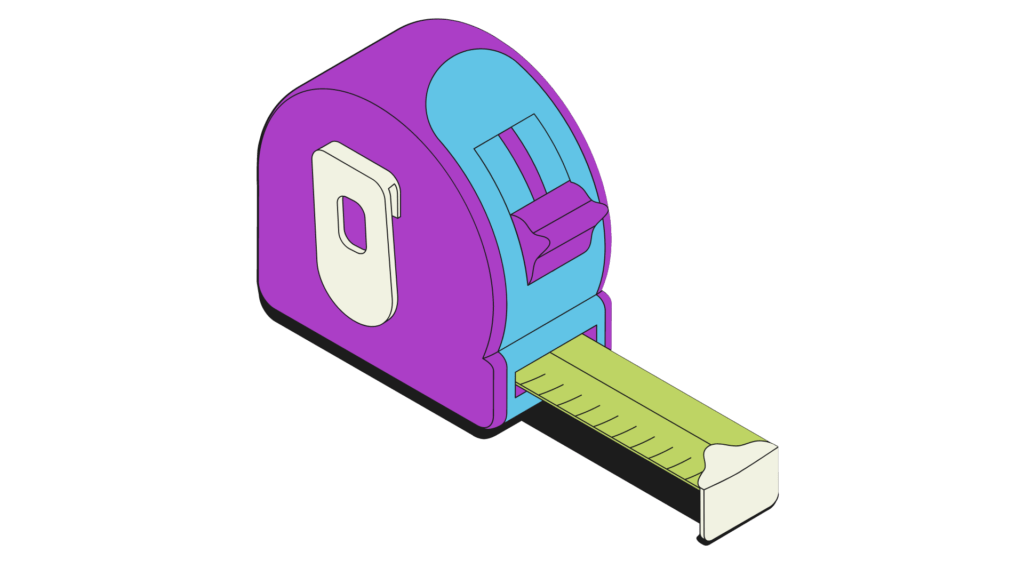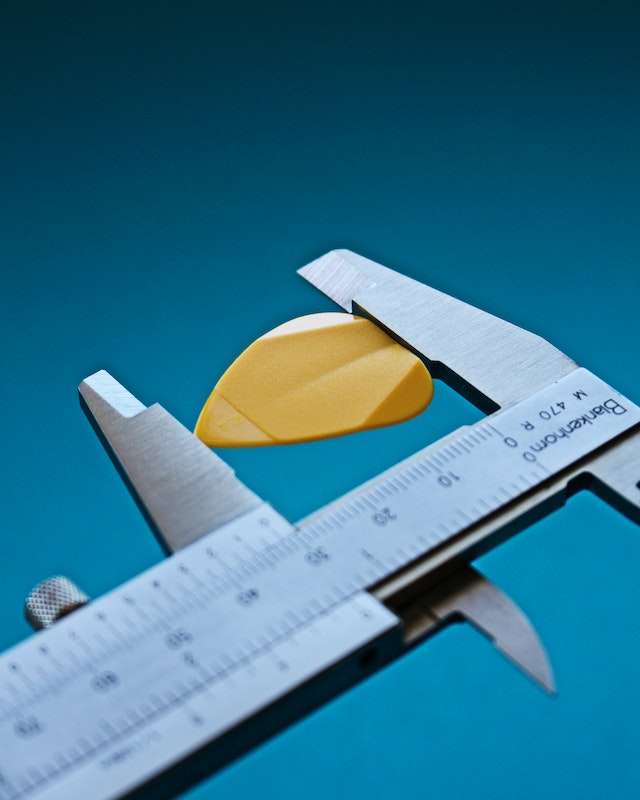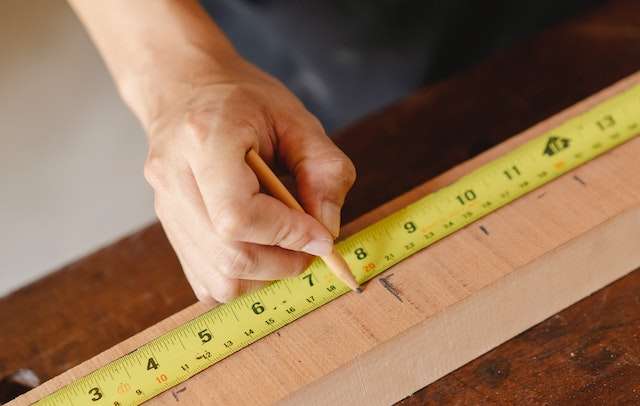
How to Write Dimensions

Writing measurements accurately is important in many areas of life. Whether you’re measuring your waistline, a liquid in a cup, or the size of a room, having the right measurement can be essential.
Knowing how to write dimensions properly can help you get it right the first time. In this article, we’ll look at different categories of measurement and provide practical examples to help improve your skills. We’ll also discuss charts and rulers that will make taking accurate measurements easier.
Key Takeaways
- Experiment with different categories of measurements to get the right measurement the first time
- Measuring categories differ between liquids and solids
- Practice measuring within different categories to memorize units for quick calculations
- Measuring furniture or room dimensions is done in feet and inches
Understanding Measurements
Understanding measurements is essential in everyday life, from cooking to furniture shopping, as it helps us get the right dimensions the first time. It’s important to understand different measuring techniques and know how to convert between different units of measurement.
When taking measurements, precision is key and common mistakes such as mixing up inches and feet should be avoided. Measuring irregular shapes can be a challenge; however, with the right technique, it’s possible to get an accurate measurement. Knowing how to measure correctly is also helpful when determining the size of objects for specific tasks such as finding materials for DIY projects or determining clothing sizes.
When working with measurements, it’s important to use appropriate measuring tools that are suited for the task at hand. For example, a ruler might not always be suitable if you need more precise measurements because rulers are limited in their accuracy level due to their predefined increments. A tape measure, on the other hand, may offer greater accuracy since they often have smaller increments which makes them ideal for measuring irregular shapes or when needing exact dimensions such as inside corners of frames or doorways.
In addition, understanding how each unit relates to one another can help make conversion easier and faster without having to look up conversion rates every single time you need one. This knowledge will give you an advantage when completing complex tasks that require multiple steps involving unit conversions such as converting millimeters into centimeters then into meters or liters into quarts then gallons, etcetera.
With this understanding of basic measuring techniques combined with practice using these tools regularly, you’ll ensure you get the right dimension every time without making any costly mistakes!
Categories of Measurement
Gaining familiarity with the various categories of measurements can help you get the right measurement every time. Being able to accurately measure and convert units is essential for accurate measuring, and there are a few different techniques that you can use to ensure accuracy. Additionally, having the proper tools and understanding common measurement errors will also improve your accuracy when writing dimensions.
There are three primary types of measurements: solid, liquid, and gas.
The most commonly used measuring technique for solids is using inches, feet, grams, or tablespoons depending on what you’re measuring.
For liquids, cups, liters, or gallons are usually used as a unit of measurement while gases tend to be measured in cubic centimeters (cm³).
Practicing within each category will help you become more familiar with how much each unit measures so when it comes time to write down your measurements, they’ll be exact and correct.
To make sure your measurements stay precise, it is important to keep track of any conversions that need to be done between units since they don’t always match up perfectly. For example, one inch does not equal one centimeter – one inch equals 2.54 centimeters. So if you were converting inches into centimeters, you would have to multiply by 2.54 instead of just changing out the unit symbol from in to cm.
Lastly, being aware of potential errors such as reading mismatched scales or misunderstanding decimal points can help avoid mistakes in writing dimensions which could lead to inaccurate results later on down the line.
Solids Measurement
Measuring solids is an essential skill for accurate results, so it’s important to hone your measuring technique and always be aware of conversions between units.
The most common tools used for measuring solids are rulers, tape measures, and calipers. It’s important to use the correct tool for precision measurement. For example, a ruler is suitable for smaller objects like jewelry or clothing while a tape measure is ideal for larger items like furniture or walls.
Always double-check that your measurements are exact before converting them into different units. This helps avoid errors when making calculations with multiple measurements. When converting between units, it’s also important to take into account any differences in accuracy due to their varying scales.
When working with precision measurements, it’s crucial to use proper techniques to ensure accuracy and consistency. Start by lining up one end of the measuring tool against the object being measured and make sure that the markings line up perfectly before taking a reading. To get an even more accurate measure, consider using two hands instead of one on longer measuring tools like tape measures.
Lastly, make sure to record all measurements accurately either manually or electronically as you go along. This way, they can be referred back to in case of mistakes or discrepancies later on in the project.
To maximize accuracy when measuring solids, it’s crucial to understand how each unit works and how they convert from one unit to another. Familiarize yourself with charts and diagrams depicting standard conversion rates between various measurement systems such as inches (in), centimeters (cm), and millimeters (mm). With practice and patience, these skills will become second nature, allowing you to work efficiently with maximum accuracy when dealing with solids measurements.
Moving onto liquids measurement now requires an entirely new set of techniques, which will be discussed in the next section…
Liquids Measurement
Mastering liquid measurements can be a tricky task, but with a bit of practice and patience, it’s possible to become an expert in no time. Measuring liquids accurately involves understanding the metric system and conversion factors.
Kitchen tools such as measuring cups, spoons, syringes, beakers, and jugs are essential for making accurate measurements. Knowing how to use each tool correctly is also important for achieving accuracy and precision.
It can also help to double-check any measurement before crafting a dish or using them in recipes. Understanding the difference between teaspoons, tablespoons, and milliliters is key when working with liquids. Learning how to convert from one unit of measurement to another is crucial for accurate results. For instance, knowing that 1 tablespoon equals 15 milliliters helps you get precise measurements every time you cook or bake something at home.
Using a digital kitchen scale can help ensure consistency when measuring amounts of ingredients over long periods of time. Taking into account temperature differences in various locations will also help you get more reliable readings when dealing with liquids since they expand or shrink depending on the environment they’re stored in or exposed to.
With practice and experience, you’ll soon find yourself confidently mastering liquid measurements like an expert!
Cooking Measurement
Cooking requires precise measurements to create delicious dishes, so it’s important to get the hang of measuring ingredients correctly! Whether you’re an amateur cook or a chef, having the right tools and knowing how to measure correctly can make all the difference.
Measuring precision is key when it comes to cooking; if there’s too much of any ingredient, your recipe could be ruined. Here are some tips for accurate measuring:
- Understand ingredient conversion: The same ingredient might not have the same weight or volume depending on how it’s measured. For instance, one cup of sugar has 200 grams while one cup of flour has only 140 grams.
- Have the right tools: Having the correct measuring tools in your kitchen will make following recipes easier and more accurate. Common kitchen mistakes include using a tablespoon instead of a teaspoon or misreading imperial measurements as metric ones. Make sure you have reliable spoons and cups that are clearly labeled with their measurement sizes.
Knowing how to use these additional features will help you avoid common kitchen mistakes and ensure accuracy when preparing meals. With practice and patience, you’ll be able to master measuring ingredients for any recipe!
Furniture Measurement
Getting furniture dimensions right is a must if you want to create the perfect space, so don’t let measuring your furniture be a chore – make it an enjoyable experience! Measuring accuracy is essential when it comes to furniture and other home items; even the slightest mistake can have major consequences.
When faced with this task, having the right measurement tools is key. From traditional tape measures to laser-guided devices, there are numerous options out there that can help you get accurate measurements. Common mistakes include failing to convert units correctly and not taking into account small details such as rounding off numbers or forgetting about fractions of inches. Make sure you take your time and double-check all your measurements–the importance of precision cannot be overstated.
When measuring room dimensions for furniture, always remember that length precedes width which precedes height measurement. In addition, when measuring in feet, use a ruler or yardstick instead of a tape measure as it will provide more accurate results due to its longer length.
If your measurements do not line up exactly with standard unit sizes (i.e., inches or centimeters) then try converting them into more manageable units like feet and yards for easier calculations and fewer mistakes. Finally, when dealing with any kind of measurement task, pay extra attention to detail and keep track of all your calculations–it’s better to double-check than regret later!
Organizing a room by getting all the furniture measurements just right requires patience and diligence; however, following these tips will ensure that your efforts will pay off in the end by creating the perfect space for you or your family!
Room Measurement
Room-measuring’s a breeze if you follow these tips! Measuring tools like rulers, measuring tapes, and yard sticks are essential for getting accurate measurements.
When measuring room dimensions, it’s important to take into account common mistakes such as miscalculating fractions of an inch or mixing up units of measurement. Furthermore, converting units can be tricky because of the different formats used in different countries. For instance, when converting from metric to imperial units or vice versa, pay attention to the conversion factors.
Additionally, when measuring irregularly shaped spaces or items that need precise measurements for renovations, use more than one type of tool and double check your results for accuracy. Finally, mark down all measurements on paper so that they can be easily referenced later on when creating charts and using rulers to calculate distances between points more accurately.
Charts and Rulers
Charting and ruling can be a breeze with the right tools! To help make the process easier, using charts and rulers to measure distances between points more accurately is essential.
With a few simple tricks, you’ll be charting and ruling like a pro in no time! Start by learning how to use measurement tools correctly. Make sure you understand how to convert units, measure accuracy, and avoid common mistakes. It’s also important to know how to measure irregular shapes without making errors or wasting time.
When measuring with charts or rulers, it’s best to have two people working together for maximum accuracy. Have one person hold the chart or ruler while another marks off measurements along the item being measured. Make sure both people are aware of any irregularities that may affect measurements before proceeding.
Double-check all measurements before recording them on paper or entering them into a computer program. Finally, take your time when measuring with charts and rulers. Rushing through can result in errors that could cost you money down the line if not caught in advance. By taking your time and double-checking each measurement as you go, you’ll ensure that every measurement is accurate and reliable!

Practical Examples
You can use the same skills you’ve learned to measure your waist, bust, and hips in inches, or to measure liquid or solid measurements in cooking with cups, quarts, gallons, teaspoons, and tablespoons.
It’s important to be aware of the common mistakes when measuring such as using the wrong unit conversions or not being precise vs accurate. To ensure accuracy, it’s best practice to always double check each measurement taken.
Measuring irregular shapes can also become difficult due to their unique dimensions but with practice and knowledge of measuring techniques, you can write a more accurate number measurement dimension for any shape.
Make sure that you take into account all variables when taking measurements so that there is no room for error. And although it may be tedious at times, make sure each individual measurement is written down correctly and accurately before doing any calculations as this will save time and money in the long run.
Frequently Asked Questions
What other units of measurement are used besides inches, feet, grams, and tablespoons?
You should also measure in Kilograms, Liters, Ounces, Millimeters, and Miles. Be precise and accurate when taking measurements for the best results. Use appropriate units for liquids or solids to get the right measurement every time. Don’t forget to consider distance in Miles too.
Are there any other tips for writing number measurements?
You, sophisticated reader, should also consider converting units when writing measurements. Whether metric or imperial system, accuracy is key. Further, look into area and volume measurements to ensure precision. All of this requires attention to detail for the best results.
How can I practice measuring in different categories?
To practice measuring in different categories, use the metric system and include decimals for precision. Measure length in centimeters, volume in liters, and weight in ounces. Make sure to be accurate and precise when taking measurements as this is essential when working with numbers.
Are there any other references for measurement charts and rulers?
Yes! You can also find metric system conversion tables, scale drawings, time unit charts, and volume charts to help you with measurements. Allude to the bigger picture of mastering measurement skills and be precise in your work for accurate results.
How will this article help me in my pursuit of a career in science or engineering?
This article will help you in your pursuit of a career in science or engineering by teaching you how to accurately and precisely measure dimensions. It covers topics such as scientific notation, metric system, conversion tools, dimensional analysis, and measurement accuracy. With this knowledge, you’ll be well-equipped for any challenge!
Conclusion
You’ve got the basics down! Now you know how to write dimensions accurately and precisely. You can measure anything from solids, liquids, or even a room with confidence. Remember to always use charts and rulers for reference if needed.
With your newfound knowledge, you can confidently make measurements in any situation – making sure you get it right the first time every time! So go forth and conquer those measurement challenges with ease – you’ve got this!
Utilizing an analogy of a chef measuring ingredients for a recipe, we exhort you to keep on cooking up accurate measurements. Bon Appetit!
